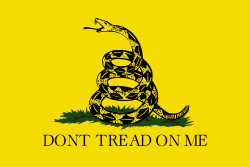The Flags of the American Revolution
|

|
|
Share This Page
|
|
|
|
|
|
|
Follow This Site

|
 |
|
|
|
|

|
A flag can be a powerful symbol, of a people or a country or a movement. That was certainly the case during the American Revolution, when the rebelling colonists adopted many flags to fly over their rebellion against the British.
 One of the most recognizable images of the revolution was the snake, usually coiled, and the words "Don't Tread on Me." (This was an update of Benjamin Franklin's "Join Or Die" image.) The snake was a rattlesnake, and its rattles were coiled, ready to strike. This image appeared in a newspaper cartoon and then on a few flags, including the Gadsden Flag, which had an iconic yellow background.
One of the most recognizable images of the revolution was the snake, usually coiled, and the words "Don't Tread on Me." (This was an update of Benjamin Franklin's "Join Or Die" image.) The snake was a rattlesnake, and its rattles were coiled, ready to strike. This image appeared in a newspaper cartoon and then on a few flags, including the Gadsden Flag, which had an iconic yellow background.
The snake made another appearance, this one uncoiled, on the first Navy Jack. This flag, called the "Rebellious Stripes," was created to coincide with the Stamp Act Congress and featured a rattlesnake rippling across 13 (alternating) red or white stripes. The Navy Jack flew on ships of the Continental Navy.
 A tree, specifically a pine tree, was also a symbol on several Revolution-era flags. The inscription "An Appeal to Heaven" accompanied a green pine tree on a white flag that flew atop some colonial ship masts. The pine tree appeared on land as well, on flags of New England. The First Flag of new England featured the traditional English red background but added a tiny gree pine tree to the top-lefthand corner of the St. George's red-and-white cross, which itself was in the top-lefthand corner of the flag. The New England flag during the war removed the cross entirely and enlarged the tree to fill the space. The Bunker Hill Flag (left), which flew above colonial troops at the eponymous battle, kept the cross and the small pine tree but substituted a blue background.
A tree, specifically a pine tree, was also a symbol on several Revolution-era flags. The inscription "An Appeal to Heaven" accompanied a green pine tree on a white flag that flew atop some colonial ship masts. The pine tree appeared on land as well, on flags of New England. The First Flag of new England featured the traditional English red background but added a tiny gree pine tree to the top-lefthand corner of the St. George's red-and-white cross, which itself was in the top-lefthand corner of the flag. The New England flag during the war removed the cross entirely and enlarged the tree to fill the space. The Bunker Hill Flag (left), which flew above colonial troops at the eponymous battle, kept the cross and the small pine tree but substituted a blue background.
 Also appearing on flags of the period was the word "Liberty." Such was the case with the Moultrie flag, which flew at the Sullivan's Island fort near Charleston, S.C., as American troops fought off a British bombardment that kept the city of Charleston save from occupation for what turned out to be four years.
Also appearing on flags of the period was the word "Liberty." Such was the case with the Moultrie flag, which flew at the Sullivan's Island fort near Charleston, S.C., as American troops fought off a British bombardment that kept the city of Charleston save from occupation for what turned out to be four years.
The alternating red or white stripes were a popular unifying symbol, of the 13 colonies banding together. Nearly all flags showing the red-and-white stripes had the stripes running horizontal. An exception to this was the Sons of Liberty Flag, which had vertical stripes and only nine, five red and four white.
The popular stars-and-stripes "Betsy Ross" flag gained popularity in the early years of the war and has endured as a symbol of the revolution.



 One of the most recognizable images of the revolution was the snake, usually coiled, and the words "Don't Tread on Me." (This was an update of Benjamin Franklin's "Join Or Die" image.) The snake was a rattlesnake, and its rattles were coiled, ready to strike. This image appeared in a newspaper cartoon and then on a few flags, including the Gadsden Flag, which had an iconic yellow background.
One of the most recognizable images of the revolution was the snake, usually coiled, and the words "Don't Tread on Me." (This was an update of Benjamin Franklin's "Join Or Die" image.) The snake was a rattlesnake, and its rattles were coiled, ready to strike. This image appeared in a newspaper cartoon and then on a few flags, including the Gadsden Flag, which had an iconic yellow background. A tree, specifically a pine tree, was also a symbol on several Revolution-era flags. The inscription "An Appeal to Heaven" accompanied a green pine tree on a white flag that flew atop some colonial ship masts. The pine tree appeared on land as well, on flags of New England. The First Flag of new England featured the traditional English red background but added a tiny gree pine tree to the top-lefthand corner of the St. George's red-and-white cross, which itself was in the top-lefthand corner of the flag. The New England flag during the war removed the cross entirely and enlarged the tree to fill the space. The Bunker Hill Flag (left), which flew above colonial troops at the
A tree, specifically a pine tree, was also a symbol on several Revolution-era flags. The inscription "An Appeal to Heaven" accompanied a green pine tree on a white flag that flew atop some colonial ship masts. The pine tree appeared on land as well, on flags of New England. The First Flag of new England featured the traditional English red background but added a tiny gree pine tree to the top-lefthand corner of the St. George's red-and-white cross, which itself was in the top-lefthand corner of the flag. The New England flag during the war removed the cross entirely and enlarged the tree to fill the space. The Bunker Hill Flag (left), which flew above colonial troops at the  Also appearing on flags of the period was the word "Liberty." Such was the case with the Moultrie flag, which flew at the Sullivan's Island fort near Charleston, S.C., as American troops fought off a British bombardment that kept the city of Charleston save from occupation for what turned out to be four years.
Also appearing on flags of the period was the word "Liberty." Such was the case with the Moultrie flag, which flew at the Sullivan's Island fort near Charleston, S.C., as American troops fought off a British bombardment that kept the city of Charleston save from occupation for what turned out to be four years.
